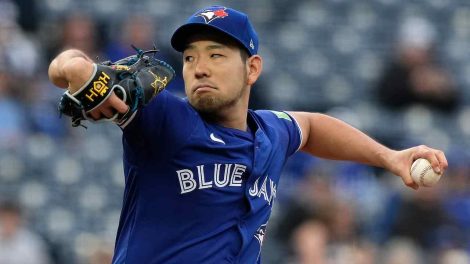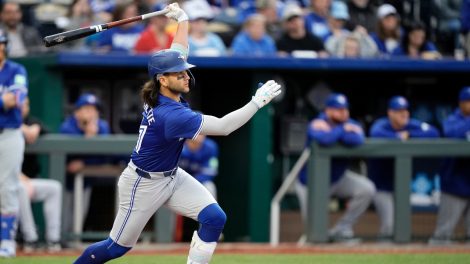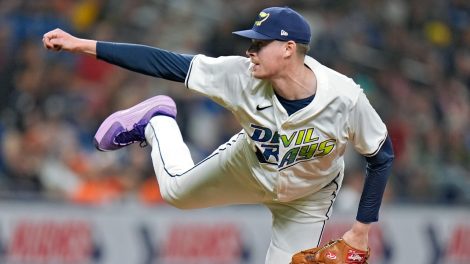One of the most frustrating attributes in a pitcher is the tendency towards nibbling around the edges. By this, I’m not talking about painting the black or using the outside edges of the zone. I’m talking about the pitcher who keeps throwing pitches to the same spots, six inches off the plate, in the hopes of snagging a few gimme strikes or some errant swings. Nobody succeeds with that approach.
Now let me flip that into a metaphor to commiserate with those of you who spent some of the initial weeks of the season in frustrated fits at the manner in which Alex Anthopoulos has managed the Toronto Blue Jays’ roster both this season and over the past few years.
For the first few years of Anthopoulos’ tenure, it was easy to play along as he plucked players without options remaining from other teams, or brought in minor league free agents of dubious value.
These acquisitions weren’t just low-hanging fruit; they had already fallen off the tree and were sitting on the ground by the time the Jays’ GM picked them up. But it was the era of “asset management” and “market inefficiencies,” so fans were happy to indulge the Jays as they crammed an Aaron Laffey or a Jo-Jo Reyes into the rotation, or attempted to wring something out of Jeremy Jeffress, or kept Jayson Nix on the big league roster. You could live with some picking and nibbling.
But some time after last season’s major acquisitions, the perspective on these marginal moves seems to have shifted. It probably has a lot to do with spending a large part of what was promised to be a dream season watching Chien-Ming Wang and Ramon Ortiz and Todd Redmond take the hill as the team sputtered and spun off the road repeatedly. Putative World Series favourites don’t fool around with rosters that include that marginal level of talent.
It also left fans feeling increasingly impatient with the notion of protecting a player’s big league roster spot for fear of losing him on waivers. In John Farrell’s last year with the team, the idea of “bringing the best 25 guys north” gained some resonance, and it’s an ideal that is brought out often lately when these players who occupy the bottom slots on the roster aren’t being replaced quickly enough.
And I get this. I really do. The idea that there are spots in the bullpen which are now occupied by eminently replaceable pitchers like Esmil Rogers when there are perhaps better options waiting in the wings is clearly frustrating. Watching players like Ryan Goins and Moises Sierra play like minor leaguers who are out of their depth for weeks on end is no picnic. You want your team to do everything that it can to win on every night, so the cheap out that they give away here or the terrible inning that they offer there is enough to have you calling for change before the other guys’ handshake line disperses.
That said, there are two reasons why I’ll hold my tongue on some of these moves, or give something resembling the benefit of the doubt to the general manager for the time being.
Firstly, I think that a team always has to think a couple of steps down the board when it comes to roster depth. Sure, we could heave Redmond or Rogers into the volcano after a bullpen meltdown, but then what?
And what happens when the inevitable injuries leave you with the decision such as moving a young and probably under-prepared player up while likely losing someone off your 40-man roster to accommodate him?
It doesn’t take that many discards before you’re staring at a thin hand that you’ve dealt yourself. Maybe that means a couple of weeks with Neil Wagner unfairly getting the bum’s rush to Buffalo, but it at least keeps you from cycling in even lesser-skilled players if you lose marginal talent to waivers and worthy talent to injuries.
Maybe what we’re struggling with here is the notion of what is “replaceable”. The “R” in Wins Above Replacement is a somewhat cold and calculated figure, but its relationship to the current market is somewhat tenuous. Yes, you can easily replace the lousy performance with another player of marginal-but-maybe-slightly-
The second reason why I’ll be a little more willing than some to hold my nose and stick with some of these marginal talents is that I’ve seen some of them evolve into actual frontline players in recent years. My silly devotion to underdog players like Brian Tallet or Jo-Jo Reyes or Moises Sierra is not really any different from the belief that I had in Jose Bautista or Edwin Encarnacion. Maybe that feels like I’m trying to over-egg the pudding to make this point, but I can absolutely tell you that at various times, I had it suggested to me that they were expendable or superfluous.
Maybe now that he’s gone, I can admit to myself that Moises Sierra is unlikely to ever be an MLB All-Star. Maybe he wasn’t the right fit for this team at this time. But I didn’t mind that the Jays gave him a longer look to see if there was still something worthy in the player.
Every game counts, and that’s surely the case in the 2014 American League East. But fans should acknowledge that “putting the best team on the field” is an easy phrase to roll off the tongue, but not as simple a task for Alex Anthopoulos to put into action.










